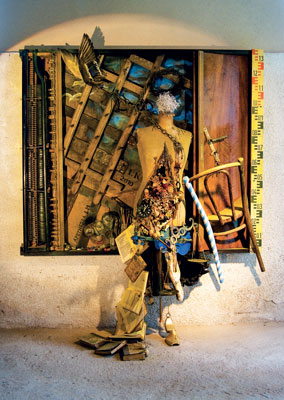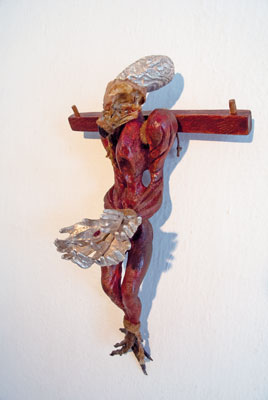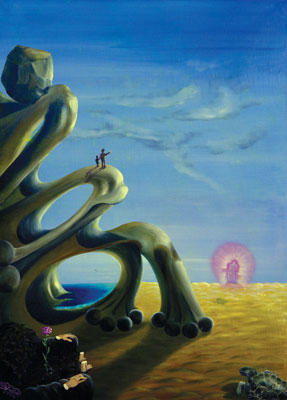Mission of Lubo Kristek
 Instead of a constant search for something new, in his work Lubo Kristek looks inside himself. He looks for what we have lost in the frenzied search for novelty. The ability to see things in context. He presents his own language to the viewer, a language that does not talk to reason but to the senses, in a manner comparable to a dream.
Instead of a constant search for something new, in his work Lubo Kristek looks inside himself. He looks for what we have lost in the frenzied search for novelty. The ability to see things in context. He presents his own language to the viewer, a language that does not talk to reason but to the senses, in a manner comparable to a dream.
But this is no metalanguage, no universal rules. Kristek’s language is reborn with each event. It does not proceed according to predefined rules, but rather his works examine the rules. With each happening, it reveals the inner correlation of phenomena piece by piece. It combines that which was isolated and often also sleeping below the surface.
But it is not a world without order. It is as if the DNA helix runs through the work of Lubo Kristek and can take on an endless number of forms and be expressed in its current completeness at every moment.  Or, if we accept Kristek’s concept of holographic perception of a happening, we can also say that in every one of his works the entire picture is contained, his entire message, and the more of his works we get to know, the sharper, more detailed and more plastic is the picture formed in our minds.
Or, if we accept Kristek’s concept of holographic perception of a happening, we can also say that in every one of his works the entire picture is contained, his entire message, and the more of his works we get to know, the sharper, more detailed and more plastic is the picture formed in our minds.
In Kristek Thaya Glyptotheque, there is a combination of intentions and directions that had previously existed in the creator’s mind independently of each other. The artist allows more than just art, theatre and musical expressions to flourish. He has imprinted his world view and lifelong direction on this sculptural pilgrims’ way. His intent is to create a place where people and muses can meet and which would be the symbol of an active approach to one’s own life and the world around us. The Glyptotheque is now blending in with its surroundings. Cultural events are held at the stations, sculptures become part of the local heritage, traditions and legends, people bring flowers and other items to them, and they arrange rendezvouses at them. Photographs appear in local chronicles and publications. Kristek Thaya Glyptotheque could be described as a journey to the spiritual, to that which exceeds us but is also deeply rooted in us.
 Each work of Lubo Kristek constitutes his personal prayer. During moments of concentration and creation, such as clear existence, he chooses his next direction. Via the happenings, he reveals this process to others and he invites anyone who wants to enter into his creative space where the transformation is occurring.
Each work of Lubo Kristek constitutes his personal prayer. During moments of concentration and creation, such as clear existence, he chooses his next direction. Via the happenings, he reveals this process to others and he invites anyone who wants to enter into his creative space where the transformation is occurring.
Through his work, he creates a space to explore the urgent questions that are trodden into the dust of the hustle and bustle of everyday life, but which lead to the very essence of society's existence. He reveals his inner self, not so as to be copied, but to inspire others to make their own discoveries.
“Art starts when you find the uncharted paths in the soul,” says Lubo Kristek.
Text: Iveta K. Pavlovičová, Barbora Půtová
Imprint
Iveta K. Pavlovičová (born 1974) is a Czech theatre studies specialist and director of the Research Institute for Communication in Arts in Brno.
She has long been engaged in the postmodern theatre and its sources. She is the author of scientific-research projects supported by the Grant Agency of the Academy of Sciences of the Czech Republic, Fund for Development of Universities, Czech Literary Fund and the European Union (European Fund for Regional Development), as well as theatre projects supported by the Ministry of Culture of the Czech Republic and the Czech-German Fund for the Future. She participated in the 3rd and 4th International Symposium of Theatre Anthropology at the Janáček Academy of Music and Performing arts Brno (JAMU), where she lectured in the years 2003–2004. She also gave a lecture at the Masaryk University Institute of Anthropology in Brno. Since 2009, she has worked on the forming of an exhibition programme at the Baroque Palace of Riegersburg.
She published the article Modely v nás a možnost jejich změny (Our Inner Models and the Possibility to Change Them) in the magazine Vesmír (2/2005) and a teaching video programme for high schools. She is the author of the textbook Tělo, znak a rytmus (Body, Sign and Rhythm) for JAMU and the book Divadlo Neslyšících a nové cesty (Theatre of the Deaf and the New Ways, 2002) that was published as part of a publication project supported by the Grant Agency of the Academy of Sciences of the Czech Republic.
Barbora Půtová (born 1985) is a Czech anthropologist and art historian lecturing at the Faculty of Arts, Charles University in Prague.
She deals with history of culture, artwork and cultural heritage. Other fields of her expert interest include historical anthropology, visual anthropology and anthropology of art.
She has published dozens of articles and experts studies as well as several expert monographs such as Pravěké umění (Prehistoric Art, co-authors Jean Clottes and Václav Soukup, 2011), Félicien Rops: enfant terrible dekadence (Félicien Rops: Enfant Terrible of Decadence, 2013), Kristkova podyjská glyptotéka (Kristek Thaya Glyptoheque, co-author Iveta K. Pavlovičová, 2013), The Genesis of Creativity and the Origin of the Human Mind (co-edited by Václav Soukup, 2015) or Královská cesta: všední i sváteční život v proměnách času (The Royal Route: Ordinary and Festive Life Over the Course of Time, 2016).
In her monograph Félicien Rops she offers the first comprehensive view of the life and work of one of the most prominent representatives of decadence and symbolism; in her last book Královská cesta (The Royal Route) she writes about the creation, development, meaning and historical changes of the Royal Route in Prague. In her book Skalní umění (Rock Art, 2015), she published the results of her field research of Palaeolithic art that she carried out at archaeological sites in France and Portugal.
At presents she is carrying out research of African rock art in the High Atlas Mountains of Morocco.
 Instead of a constant search for something new, in his work Lubo Kristek looks inside himself. He looks for what we have lost in the frenzied search for novelty. The ability to see things in context. He presents his own language to the viewer, a language that does not talk to reason but to the senses, in a manner comparable to a dream.
Instead of a constant search for something new, in his work Lubo Kristek looks inside himself. He looks for what we have lost in the frenzied search for novelty. The ability to see things in context. He presents his own language to the viewer, a language that does not talk to reason but to the senses, in a manner comparable to a dream. Or, if we accept Kristek’s concept of holographic perception of a happening, we can also say that in every one of his works the entire picture is contained, his entire message, and the more of his works we get to know, the sharper, more detailed and more plastic is the picture formed in our minds.
Or, if we accept Kristek’s concept of holographic perception of a happening, we can also say that in every one of his works the entire picture is contained, his entire message, and the more of his works we get to know, the sharper, more detailed and more plastic is the picture formed in our minds. Each work of Lubo Kristek constitutes his personal prayer. During moments of concentration and creation, such as clear existence, he chooses his next direction. Via the happenings, he reveals this process to others and he invites anyone who wants to enter into his creative space where the transformation is occurring.
Each work of Lubo Kristek constitutes his personal prayer. During moments of concentration and creation, such as clear existence, he chooses his next direction. Via the happenings, he reveals this process to others and he invites anyone who wants to enter into his creative space where the transformation is occurring.


